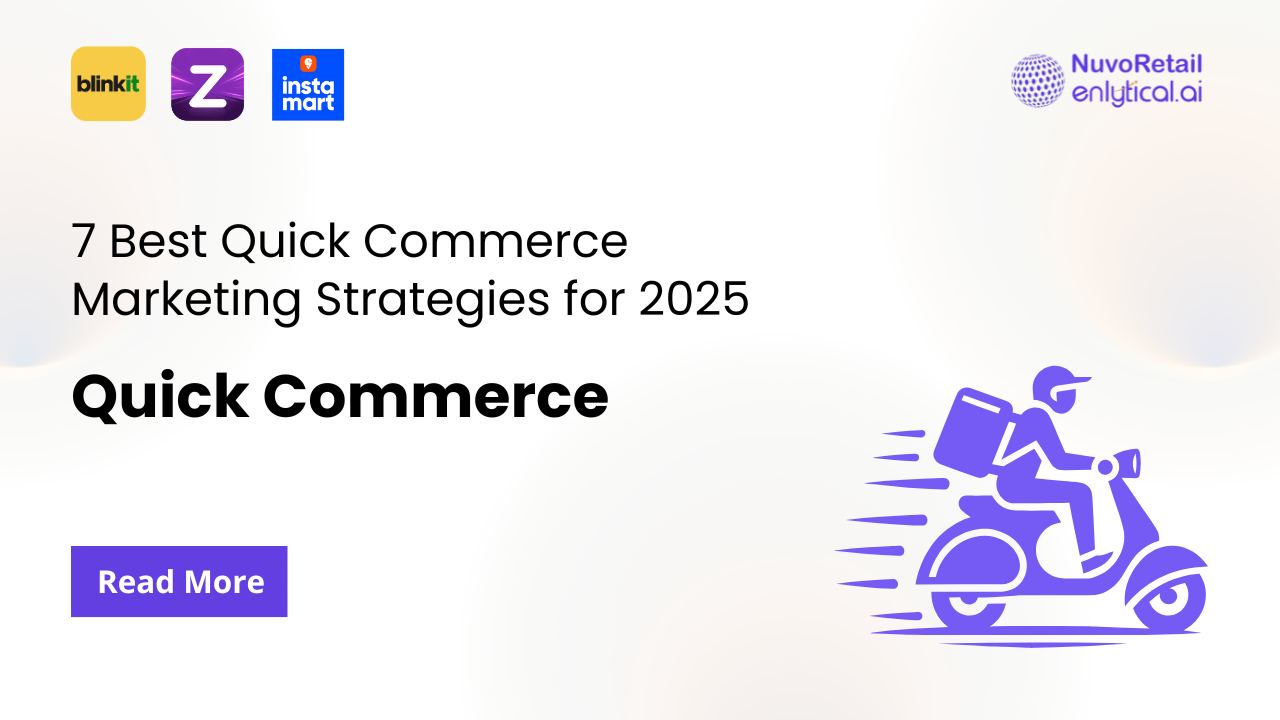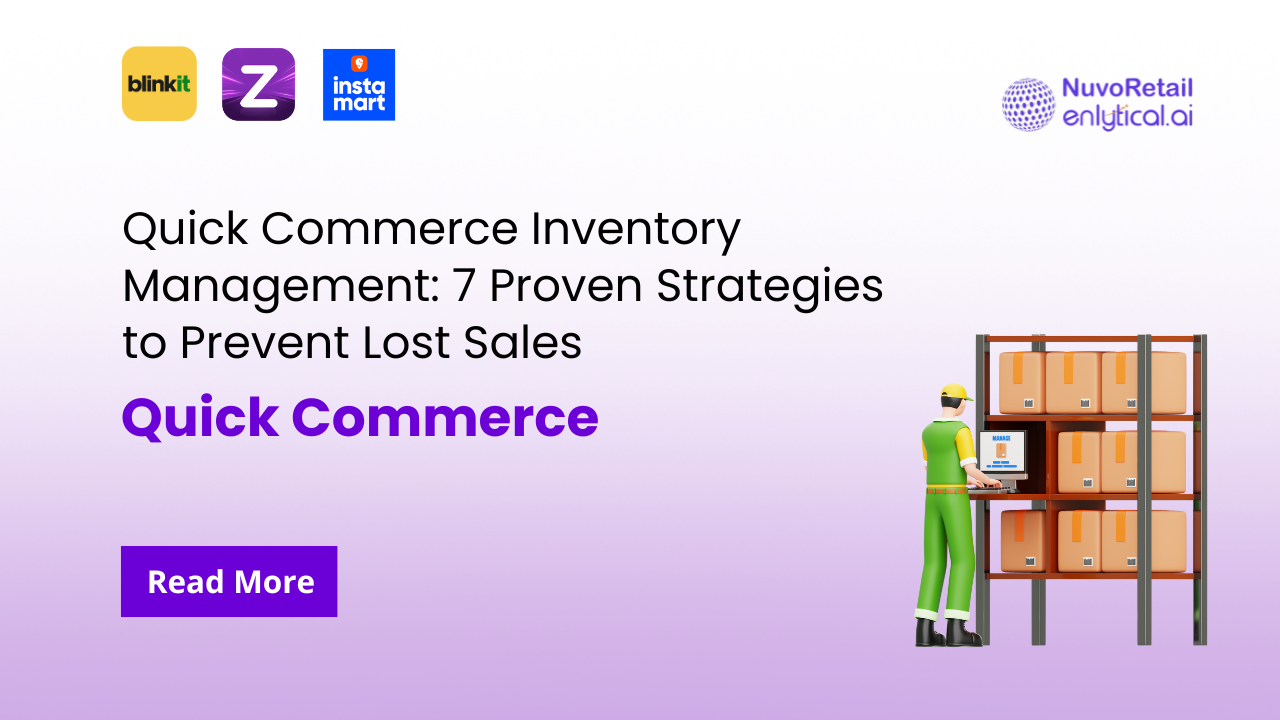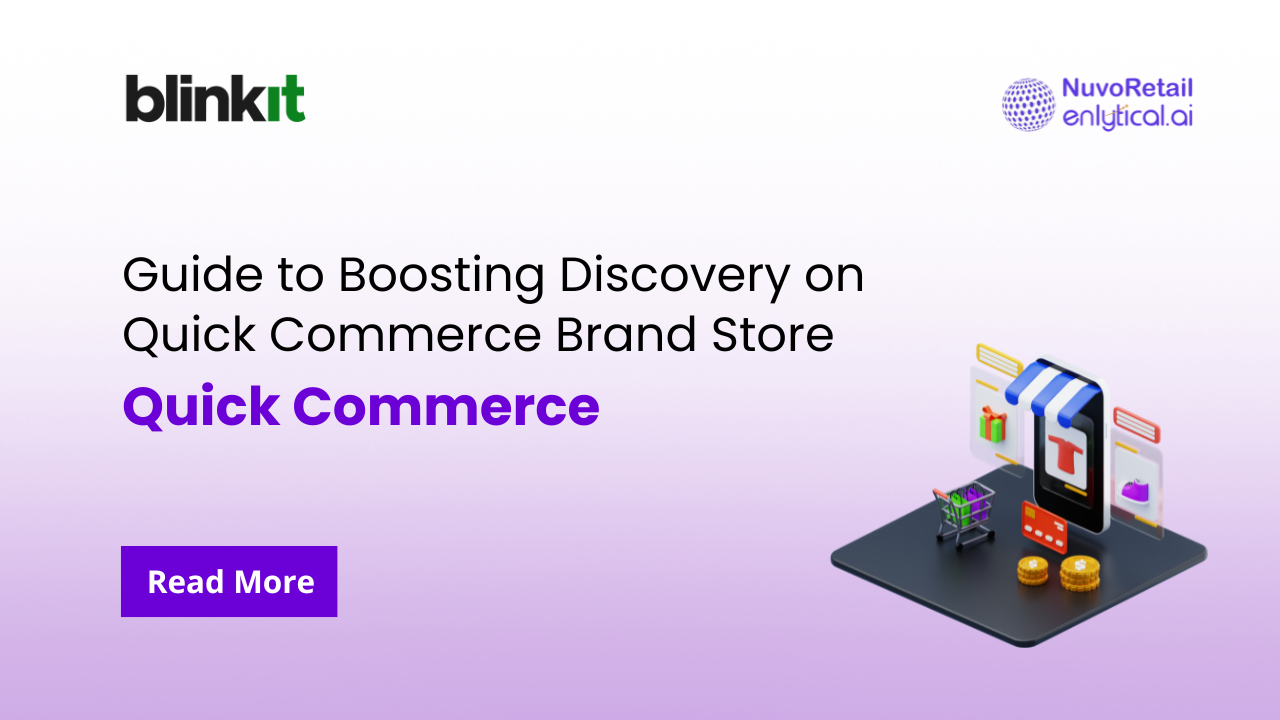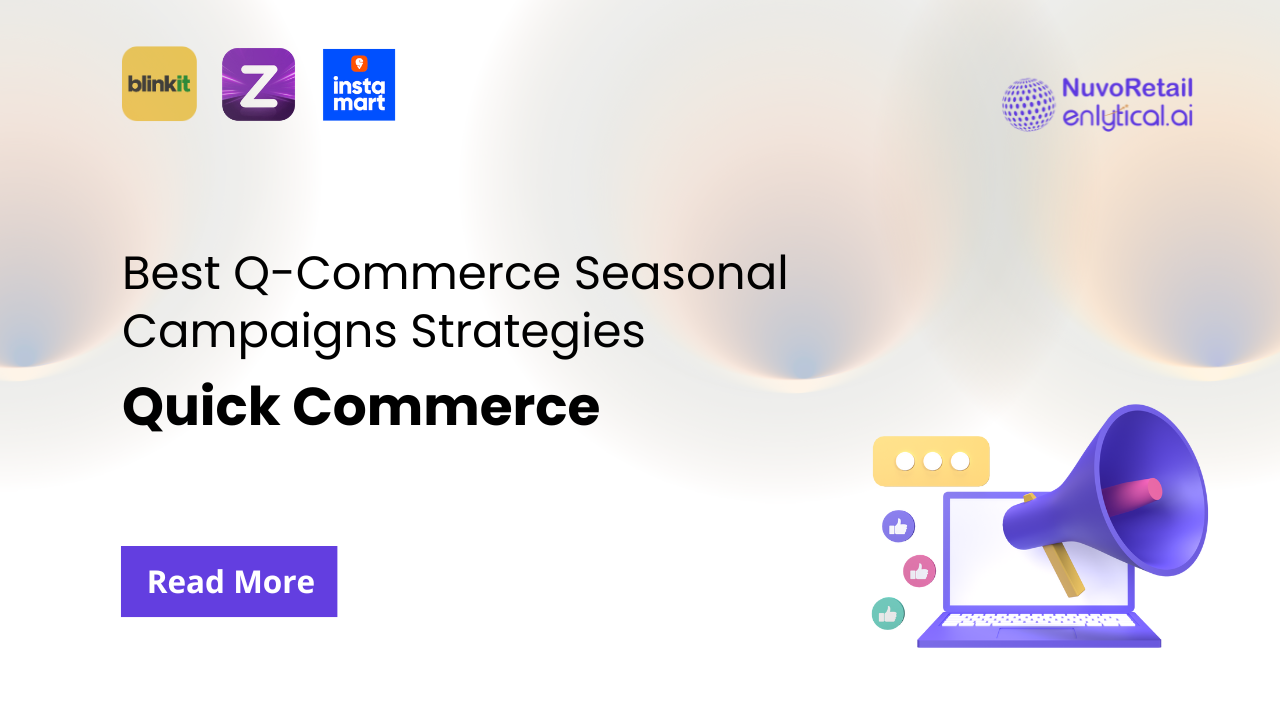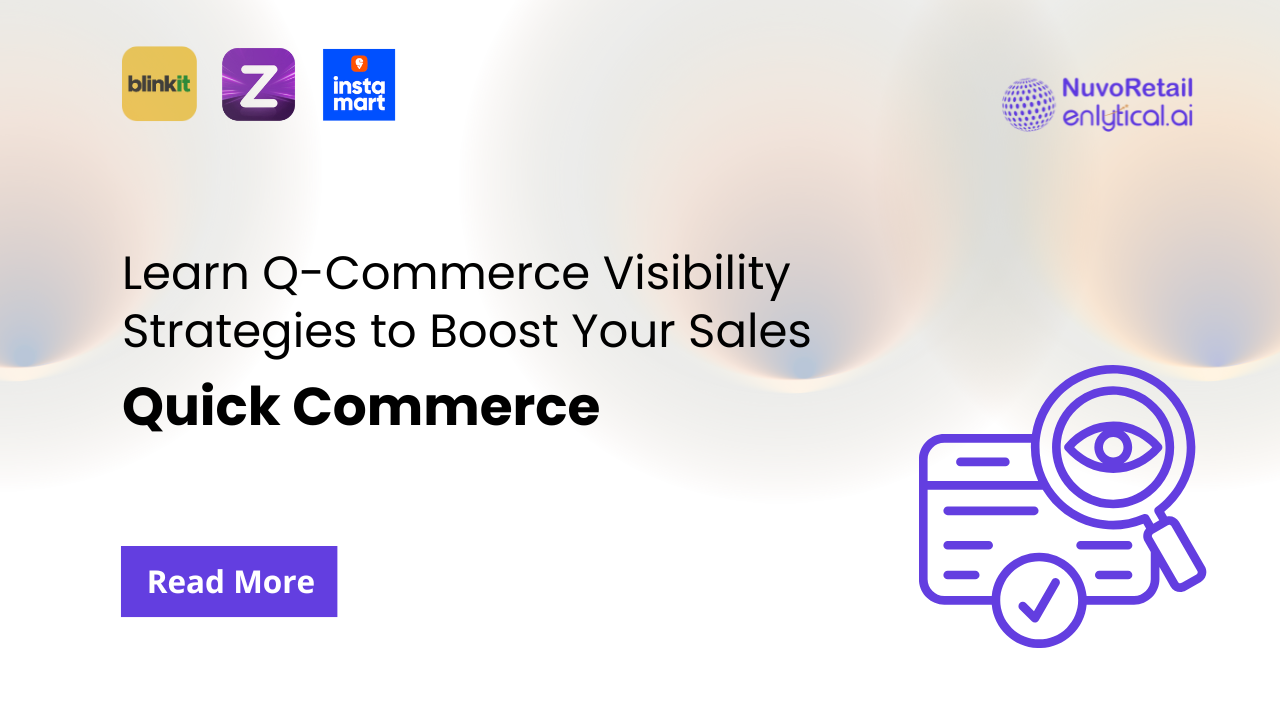Quick commerce marketing has revolutionized how consumers shop, with platforms like Blinkit, Zepto, and Swiggy Instamart delivering products in minutes rather than days. As the q commerce industry continues to explode, brands face a critical challenge: how do you capture attention and drive immediate purchases in an ultra-competitive, lightning-fast market? This comprehensive guide reveals the most effective quick commerce marketing strategies that convert browsers into buyers within minutes, helping you dominate the rapid delivery services landscape.
NuvoRetail empowers brands to thrive in the fast-paced quick commerce ecosystem with its specialized quick commerce marketing solutions. By leveraging data-driven insights, precision targeting, and omnichannel campaigns, NuvoRetail helps businesses capture consumer attention at the right moment, driving instant engagement and purchases. From optimizing in-app visibility and personalized promotions to running hyper-local campaigns that reach consumers when they’re most ready to buy, NuvoRetail ensures your brand stays top-of-mind in the ultra-competitive q-commerce landscape.
Table of Contents
- Understanding the Quick Commerce Revolution
- Strategy 1: Hyperlocal Targeting That Converts
- Strategy 2: Flash Sales and Time-Sensitive Promotions
- Strategy 3: Strategic Ad Placements on Quick Commerce Platforms
- Strategy 4: Dynamic Bundling and Cross-Selling
- Strategy 5: Influencer Partnerships and Social Proof
- Strategy 6: Inventory Optimization for Zero Stockouts
- Strategy 7: Personalization Through AI and Data Analytics
- Conclusion
Understanding the Quick Commerce Revolution
Quick commerce represents a seismic shift in retail, where delivery times have shrunk from days to mere 10-30 minutes. Platforms like Zepto, Blinkit, and Instamart have created a new consumer expectation: instant gratification. This transformation demands equally rapid quick commerce marketing approaches that align with the speed of rapid delivery.
The q commerce sector in India alone is projected to reach $5.5 billion by 2025, with consumers increasingly choosing convenience over traditional shopping. Understanding this landscape is crucial before implementing any quick commerce marketing services. The success of your quick commerce marketing campaigns depends on how well you adapt to this high-speed environment.
Strategy 1: Hyperlocal Targeting That Converts
Quick commerce advertising thrives on precision. Unlike traditional e-commerce, success in rapid delivery services depends entirely on targeting consumers within a specific radius of your dark stores or fulfillment centers. Effective quick commerce marketing begins with understanding your local audience.
Implementation Tactics:
- Geo-fencing campaigns: Target users within 2-3 km of delivery hubs with platform-specific ads
- Local event marketing: Capitalize on neighborhood events, weather patterns, and local festivals
- Regional preferences: Customize product offerings based on micro-market demands
- Time-based targeting: Show breakfast items in morning hours, dinner essentials in evenings
Hyperlocal targeting strategies have proven to increase conversion rates by up to 40% when executed correctly. According to research from McKinsey & Company, hyperlocal strategies are becoming essential for quick commerce success.
The key is understanding that Swiggy Instamart shoppers in Mumbai have different needs than those in Bangalore, and your quick commerce marketing must reflect these nuances. Every successful quick commerce marketing campaign starts with precise geographic targeting.
Strategy 2: Flash Sales and Time-Sensitive Promotions
Urgency is the heartbeat of quick commerce. Flash sales create psychological triggers that drive immediate action, perfectly aligned with the instant nature of rapid delivery. When implementing quick commerce marketing tactics, time-sensitive promotions should be your secret weapon.
Winning Flash Sale Formulas:
- Limited-time discounts: 30-minute flash deals on trending products
- Countdown timers: Visual urgency indicators on app interfaces
- Exclusive app-only offers: Reward loyal quick commerce users
- Bundle deals with expiry: “Get 3 items in 15 minutes for 30% off”
Quick commerce platforms have mastered this art, often running hourly promotions that keep users engaged throughout the day. Flash sales and dynamic bundling strategies can increase average order value by 25-35% while maintaining delivery speed.
The psychology is simple: when consumers know they can get products in 10 minutes, a flash sale becomes irresistible. Combine speed with savings, and you’ve created the perfect storm for conversions. This approach is fundamental to modern quick commerce marketing excellence.
Strategy 3: Strategic Ad Placements on Quick Commerce Platforms
Not all advertising spots are created equal in the q commerce ecosystem. Understanding where your target audience looks first can dramatically impact your quick commerce marketing ROI. Smart ad placement is a cornerstone of effective quick commerce marketing strategies.
High-Converting Ad Placement Zones:
- Homepage banners: Premium visibility for seasonal campaigns
- Category page sponsorships: Target shoppers with purchase intent
- Search result ads: Capture high-intent keyword searches
- Checkout page recommendations: Last-minute upselling opportunities
- Push notification sponsorships: Re-engage dormant users
Strategic quick commerce ad placements can boost cart addition rates by 50% when properly optimized. The key is testing different formats and positions to find what resonates with your specific audience on each platform.
Zepto and other platforms offer sophisticated targeting options that allow brands to dominate specific product categories, making them the default choice for consumers. Professional quick commerce marketing requires mastering these placement opportunities.
Strategy 4: Dynamic Bundling and Cross-Selling
Smart bundling transforms single-item purchases into basket-building opportunities, directly impacting your revenue per transaction in the quick commerce space. This quick commerce marketing technique maximizes every customer interaction.
Effective Bundling Approaches:
- Complementary products: Coffee + milk + sugar bundles for morning shoppers
- Meal solution packages: Complete dinner kits delivered in minutes
- Seasonal bundles: Weather-appropriate product combinations
- Personalized recommendations: AI-driven suggestions based on purchase history
Dynamic bundling works exceptionally well on platforms like Instamart because it reduces decision fatigue while increasing order value. When a consumer can get everything they need in one click and receive it in 15 minutes, the value proposition becomes undeniable.
According to quick commerce strategies from industry experts, bundling can increase average order value by up to 45% while improving customer satisfaction scores. This makes bundling an essential component of any comprehensive quick commerce marketing plan.
Strategy 5: Influencer Partnerships and Social Proof
Quick commerce marketing amplifies significantly when combined with influencer credibility. Micro and nano-influencers with hyperlocal audiences are particularly effective for rapid delivery services. Integrating influencer campaigns into your quick commerce marketing mix creates authentic connections.
Influencer Strategy Framework:
- Hyperlocal micro-influencers: Target neighborhood-level ambassadors
- Real-time content: Live unboxing of 10-minute deliveries
- Exclusive promo codes: Track attribution and ROI effectively
- User-generated content campaigns: Encourage customers to share their quick delivery experiences
The authenticity of watching an influencer order from Blinkit and receive groceries within 10 minutes creates powerful social proof. This strategy works because it demonstrates the core value proposition in real-time.
Combine influencer marketing with strategic platform promotions, and you create a multi-channel approach that dominates consumer awareness in your target markets. This holistic approach to quick commerce marketing delivers measurable results.
Strategy 6: Inventory Optimization for Zero Stockouts
No quick commerce marketing strategy succeeds if products aren’t available. In quick commerce, stockouts are conversion killers that damage brand reputation instantly. Your quick commerce marketing efforts must align perfectly with inventory management.
Inventory Excellence Tactics:
- Predictive analytics: Forecast demand patterns by location and time
- Real-time inventory sync: Connect marketing campaigns with stock availability
- Dark store optimization: Position fast-moving items for rapid picking
- Dynamic pricing: Adjust prices based on inventory levels and demand
Inventory optimization strategies are crucial for maintaining the promise of instant availability. When you advertise a product on Swiggy Instamart, it must be available, or you risk losing customers permanently.
Leading quick commerce brands use sophisticated demand forecasting to ensure their quick commerce marketing promotions align perfectly with inventory capacity, preventing disappointment and maximizing revenue.
Strategy 7: Personalization Through AI and Data Analytics
The future of quick commerce advertising lies in hyper-personalization. AI-driven quick commerce marketing creates unique experiences for each customer, dramatically improving conversion rates.
Personalization Implementation:
- Purchase history targeting: Remind users to reorder frequently bought items
- Behavioral triggers: Send notifications based on browsing patterns
- Time-based personalization: Market breakfast items to morning users, dinner essentials in evenings
- Preference learning: Adapt recommendations based on acceptance rates
Zepto and other platforms are investing heavily in AI to predict what users want before they know it themselves. This proactive approach to quick commerce marketing creates seamless experiences that feel magical to consumers.
Consider implementing proven quick commerce advertising strategies that leverage data for continuous optimization and improvement. Advanced quick commerce marketing requires sophisticated personalization capabilities.
Conclusion
Quick commerce marketing requires a fundamentally different approach than traditional e-commerce. The strategies outlined here – from hyperlocal targeting to AI-driven personalization—are designed specifically for the ultra-fast, convenience-driven world of rapid delivery services.
Success on platforms like Blinkit, Zepto, and Swiggy Instamart comes from understanding that your customers want everything now. Your quick commerce marketing must match this urgency with compelling offers, strategic placements, and flawless execution.
The brands winning in q commerce are those that treat speed as both a product feature and a marketing principle. By implementing these seven proven strategies, you’ll position your brand to capture immediate purchases and build lasting customer relationships in the fastest-growing retail segment. Mastering quick commerce marketing is no longer optional – it’s essential for survival.
For more tactical insights on quick commerce success, explore additional resources on quick commerce marketing tactics and stay ahead of industry trends.
Take Action Now
Ready to dominate the quick commerce landscape? Partner with NuvoRetail for expert quick commerce marketing services that drive real results. Our specialized team understands the unique challenges of rapid delivery platforms and creates quick commerce marketing strategies that convert.
Explore our quick commerce solutions or contact us today to discuss how we can accelerate your brand’s growth on Blinkit, Zepto, Swiggy Instamart, and other leading platforms.
What quick commerce marketing strategy has worked best for your brand? Share your experiences in the comments below!
